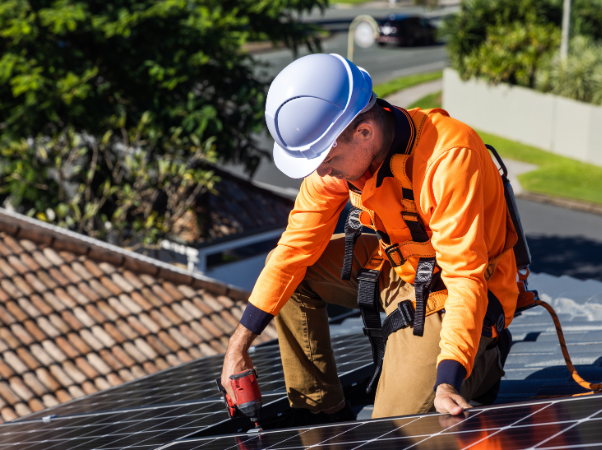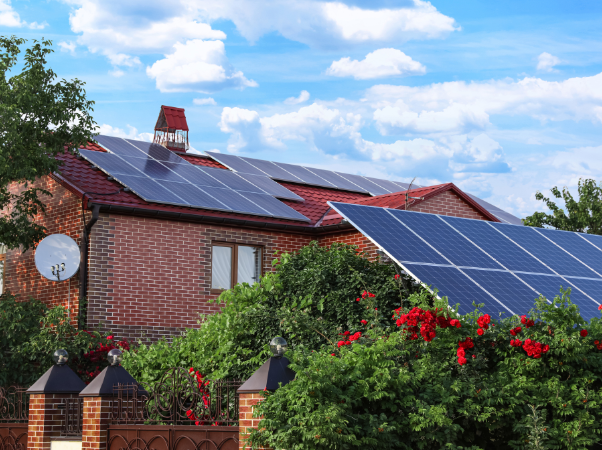Solar PV Installer Guide
Solar PV Panel Guide for Installers
Looking to upscale your installation offerings? Solar PV panels are a more popular and enticing option for homeowners than ever before.
Capture the demand and learn more about solar panel installation with our helpful guide.

What are PV Panels?
PV panels work to capture the energy from the sun and convert it into electricity. This electricity can then be used in homes and businesses, thus reducing reliance on the grid.
PV panels, or to give it its real name, photovoltaics, are also referred to as solar panels.
When this energy is absorbed and captured, it’s then diverted to the property’s fuse box to be distributed around, powering essential electrical equipment.
PV panels are usually installed on the top of a property's roof space and in the best overall position for the light to penetrate the panels. The more light these panels capture, the more potential there is to produce a greater supply of electricity to the property.
Many homes and businesses like to make use of both their PV panels and the grid to ensure a continual supply of electricity. This ensures there's no disruption when the PV panels don't manage to generate the required amount of electricity needed at a certain time.
This is especially so for cloudy days and night-time. During such times, having the grid as a backup means customers can continue to use appliances and light their properties.
Yet, some customers will want to use their PV panels as a stand-alone system and eliminate any reliance on the grid. In such cases, installers will need to ensure they have a backup plan, in the form of solar batteries, for those times when there’s not enough electricity generated through their panels.

What Is the Difference Between Solar PV and Solar Thermal?
PV panels should not be confused with solar thermal panels as they have different functions. Basically, PV panels work to produce electricity to power appliances in the property.
Whereas, solar thermal primarily uses the energy from the sun to heat your water, thus ensuring a supply of hot water to the property. Yet, there’s a fantastic opportunity for installers to discuss combining solar PV and solar thermal for the ultimate low-carbon technology property.
- Thin-Film PV Panels
Thin-film PV panels tend to be the better choice for those larger projects due to their lightweight properties. Better suited to commercial or listed buildings, rather than domestic properties, thin-film PV panels are a selection of flexible slate sheets. Made up of several thin layers of photovoltaic material, these panels demand less material when layering and are therefore more affordable.
With the ability to wrap thin-film PV panels around objects, thin-film PV panels have a minimal effect on roof space. Yet, made up in an entirely different way from monocrystalline and polycrystalline, thin-film PV isn't the most efficient of choices, with just an energy efficiency rating of 7 to 13%.
- Monocrystalline PV Panels
Monocrystalline PV panels are considered the greatest efficiency choice and, though the most expensive, they make the better choice for smaller roofs. Claimed to offer an energy efficiency rating of 15 to 20%, some properties may well find this figure reaches as much as 24%.
Composed of single-crystal silicon, monocrystalline PV Panels are the more distinct PV panel choices. Uniformed and resembling octagonal cells in style, they boast a sleek dark colour choice.
- Polycrystalline PV Panels
Distinguished by their blue mosaic appearance and angles, polycrystalline PV panels tend to be the more suitable options for residential properties. This is largely due to their affordability when compared to monocrystalline. Made up using melted silicon, the manufacturing process of these PV panels is quicker and cheaper, hence the more affordable price tag for customers.
However, though cheaper to purchase, polycrystalline does, unfortunately, have a reduced energy efficiency rating, particularly when compared to monocrystalline, at an average of 13 to 16%.
This is because of their inclusion of more than one crystal in each cell, meaning less room for the electrons to move around in these panel types.
Find the perfect type of Solar PV Panels for any installation and get the right mounts and accessories included with our Solar PV Kit Builder
What Do Customers Need To Know Before Purchasing PV Panels?
There are several factors that installers will need to make customers aware of when deciding on the best PV panels for their property.
These include:
- The outlay of panels
- Cost of installation
- Which PV panel is best suited to the property and roof space
- The number of panels required
- What planning permission may be required
- What maintenance may be needed in the future
- Whether there are any limitations to consider

Is the roof type suitable?
A customer's roof will need to be in good condition before you can install PV panels on it. An old roof or one that shows signs of weakness may not have the structural strength to hold the PV panels safely. If this is the case, you’ll have to check the roof beforehand and advise the customer of any repairs or replacements that need to be performed before continuing with the installation.
Likewise, there will need to be a clear roof space to house several PV panels, ideally around 20 square metres. Also, the roof itself can’t be too shallow or too steep as both situations will greatly impact the overall effect of any PV panels installed. For best practice, a roof pitch between 30 and 45 degrees is ideal. Otherwise, you may need to discuss the option of installing angled frames to increase the pitch here.
How many PV panels are required?
Your customer may want to fill their entire roof space or just add a few PV panels. The number required here will largely depend on their budget but also whether they want to rely solely on the electricity derived from these panels or whether they’ll want to be able to revert to the grid when necessary. A good way to help customers determine this number is by looking at their average wattage usage on their annual electricity bill.
Does the property pose any limitations?
Installers will need to consider whether there are any potential limitations facing properties when considering PV panels. As a guide, PV panels will work harder on a south-facing roof and at a 30-degree angle. Checking out the customer's property on Google Earth first will help determine their roof positioning.
Another issue to consider is the potential shading around the property. Does the building receive an adequate amount of regular daylight to power the panels? Those properties that are shaded by trees, other tall buildings, and even chimneys may encounter issues here. Though PV panels don't have to have direct sunlight to work, they’re able to produce more energy at a greater capacity if positioned correctly.
Is planning permission required for PV panels?
Though PV panels are classed as permitted developments, there may well be a few buildings and properties whereby you’ll need to check with the local authority before going ahead with a PV installation. This is especially so if the property has a listed building status, is part of a conservation area, or has a flat roof design.
As an installer, you'll also need to ensure that the customer is made aware of the potential disruption around their property for several weeks as you complete the installation. With plentiful access needed for scaffolding, there'll need to be safe and secure access outside and around the immediate property for the work to be completed.
Will PV panels require maintenance?
PV panels will require regular visual checks just to ensure that they continue to perform their best. Though this should be nothing more than a quick glance every so often, should any potential issues arise, this way they’re spotted and dealt with swiftly.
Alongside a regular visual check, customers will also need to be made aware of the need to clean the panels around twice a year or when required. This is to remove any debris that’s naturally left behind by the appearance of leaves and rain on the panel's surfaces.
What are the potential PV panel costs and installation costs?
When quoting a customer for PV panels, an installer should ideally ensure that this estimate accounts for a property to generate around 50% of its annual usage using these panels. Though figures will vary here regarding labour costs, a combination of both supplying and installing PV panels can vary with potential figures of anything from £6000 to £10,000.
Ultimately, the type of PV panel chosen will play a factor here, with thin-film the cheaper, and monocrystalline the more expensive, as will the number of panels required make a significant difference. As a general guide, a single PV panel is priced around £200 to £400 at current rates.
Learn More and Become MCS-accredited with City Plumbing and GTEC
We've partnered with GTEC to offer MCS-accredited training to take your renewable installations to the next level.
Learn how to install Solar, Air Source & Ground Source Heat Pumps, EV Chargers, and all other main types of renewable technology. Become certified to upskill your business and take advantage of increased demand ahead of net zero.





